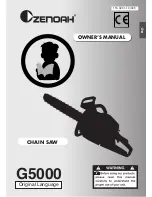
ZIPPER MASCHINEN GmbH www.Zipper-Maschinen.at
28
ZI-KTS40V-AKKU
Kickback
A kickback can occur when the tip of the guide rail touches an object or when the wood bends and
the saw chain becomes jammed in the cut. If the rail tip touches an object, this may occasionally
cause an unexpected reaction directed backwards, throwing the guide rail upwards and in the
direction of the operator. If the saw chain jams on the upper edge of the guide rail, the rail may
quickly recoil in the direction of the operator. Any of these reactions may cause loss of control of the
saw and potentially serious injuries. Do not rely solely on the safety devices integrated in the chain
saw. As the user of a chain saw, you should take various measures to be able to work without the
risk of accidents and injuries occurring. A kickback occurs when the electric power tool is used
incorrectly or erroneously.
A kickback can be prevented by taking appropriate precautions, as described below:
o
Hold the chain saw firmly with both hands, ensuring that your thumbs and fingers clasp the
handles on the chain saw. Move your body and arms into a position in which they can
withstand the kickback forces. If appropriate measures are taken, the operator can control
the kickback forces. Never release the chain saw.
o
Avoid an abnormal body posture. This will prevent you from unintentionally touching the rail
tip and will enable better control of the chain saw in unexpected situations.
o
Use only replacement rails and saw chains stipulated by the manufacturer. Incorrect
replacement rails and saw chains may cause the chain to snap and/or a kickback.
o
Follow the instructions of the manufacturer for sharpening and servicing the saw chain. If the
depth limiter is too low, there will be a greater tendency of a kickback occurring.
These risk factors can be minimized through obeying all security and operation instructions, proper
machine maintenance, proficient and appropriate operation by persons with technical knowledge and
experience.
In spite of all safety is and remains her healthy common sense and their corresponding technical
qualification / training for use of the machines most important safety factor!














































